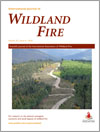International Journal of Wildland Fire
Volume 25
Number 6 2016
We modelled the effect of fuel break networks (FBNs) on burned area and fire transmission under three treatment scenarios. We found that burned area was reduced up to 17% and large-fire incidence decreased. We illustrate how FBNs contribute to the portfolio of risk management and how this approach can better inform the risk governance process.
Variable-retention harvesting can be used to create structurally complex, multi-aged lodgepole pine stands, promoting resilience to disturbances. Twelve years post-harvest, treated stands had high variability in potential fire behaviour. Although treatments increased modelled fireline intensity relative to controls, resultant overstorey structures increased thresholds necessary for crown fire propagation.
Logging following high-severity wildfire in Oregon initially led to elevated surface fuel loads and associated fire hazard compared with unlogged burned forests. By 10 years post-fire, these differences had begun to attenuate as standing fire-killed trees fragmented and live shrubs saturated the surface layer in both logged and unlogged sites.
Large wildfires in Oklahoma, USA were associated with low concurrent soil moisture in both the growing and dormant seasons, but high soil moisture during the growing season also increased wildfire probability in subsequent dormant seasons. Therefore, both wet and dry growing seasons increased wildfire probability, but at different times and for different reasons.
Semiparametric models provide a tool to predict the burned area over a particular time. The predictions obtained are competitive. The two bootstrap prediction intervals given are computationally fast. The methodology used can be applied to other hazard risks.
There is an increase in dead fuel of graminoids after winter in boreo–temperate ecosystems. This dead fuel and its low moisture content plays an important role in determining initial fire ignition. Here, we assess the probability of ignition as a function of the dead fuel moisture content, which assists in improving fire predictions.
We assessed burn severity in Siberian larch forest for different lag times, using Landsat-based indices. Assessment accuracy decreased with increasing lag time. The dNBR was the best predictor of burn severity for 7 years post-fire. After larch regeneration became established, the dNDMI became the best predictor.
Increasing risk of forest fires due to climate change is expected to limit the spread of European beech forests in the future. A regeneration assessment in 36 burnt beech stands at the Southern Alps showed, however, high resilience of this species. This demonstrates its stimulation, not limitation, by single forest fires.
Mexico is a highly diverse country and part of its diversity can only be understood by considering the high frequency of fires. A new fire science book highlights the importance of considering fire in understanding the ecology and management of Mexican ecosystems.




